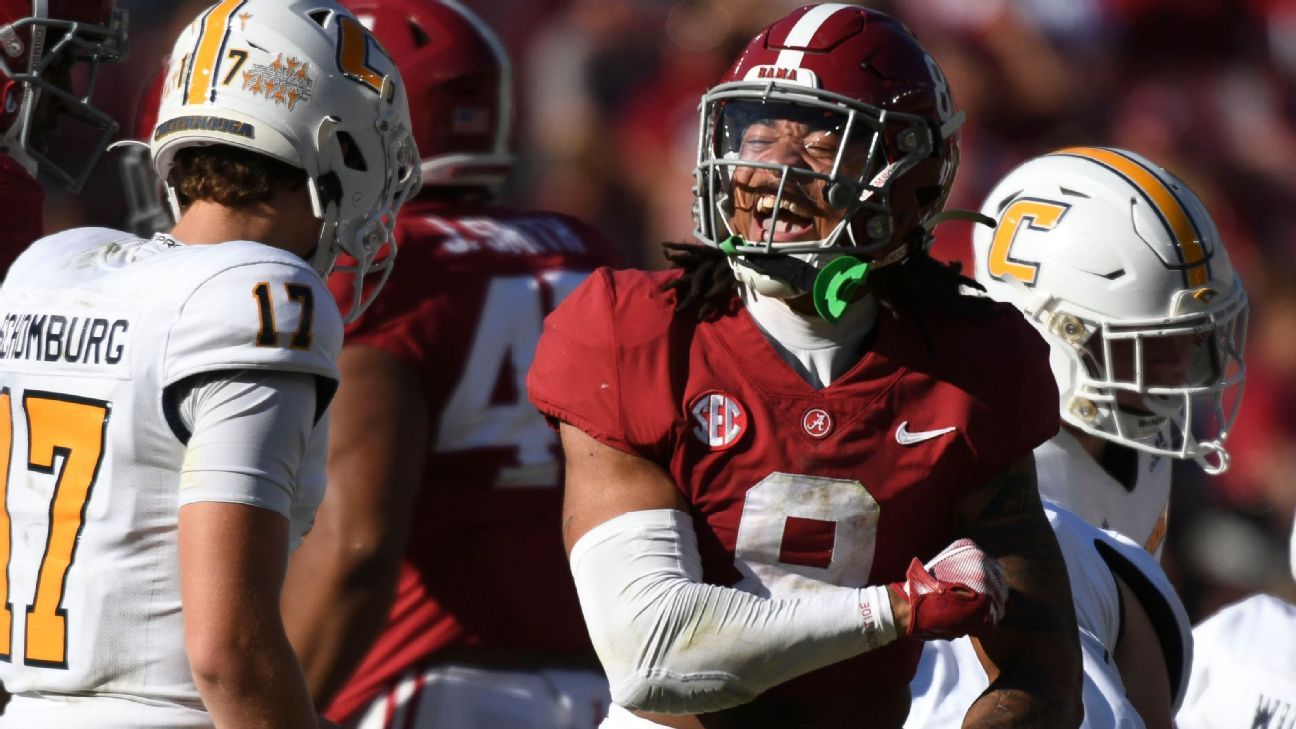
With Thanksgiving (and Rivalry Week) right around the corner, to be followed closely by Championship Week, thoughts invariably turn to potential College Football Playoff scenarios and the decisions the CFP selection committee will face.
There are more contenders than we usually see at this stage of the season, but one of them — unbeaten Florida State — was dealt a serious blow with an injury to quarterback Jordan Travis, further complicating an already complex picture.
For teams outside the playoff sphere, it’s a time to appreciate surprising success (such as at New Mexico State) or look for a fresh start and a new coach (like Syracuse).
ESPN’s college football reporters take it all in with the Week 12 takeaways.
The 12-team CFP is coming a year too late
This would have been the perfect season to start the 12-team playoff field, which doesn’t begin until next year. There haven’t been this many contenders this deep into the season before during the four-team playoff era. Four of the Power 5 conferences still have at least one undefeated team remaining, the lone exception being the Big 12. There are still eight teams with a path to the playoff — nine if you include Louisville, though the selection committee would have a hard time getting past the Cardinals’ loss to Pitt, and other conference champs will likely have stronger résumés.
Ohio State-Michigan will settle itself on the field, but this could still be the selection committee’s toughest task in a decade. While the weekly Tuesday rankings have lacked drama and major movement, the more they stay the same, the more difficult it will be on Selection Day.
Possibly the most challenging scenario would be if Alabama beats Georgia in the SEC championship game, one-loss Texas wins the Big 12 and two other undefeated conference champions — in addition to the Big Ten champ — remain. The Longhorns’ head-to-head win at Alabama will continue to loom large as long as their records are the same and their résumés are comparable. — Heather Dinich
Florida State presents test case for CFP committee
Florida State’s fortunes may have changed on a dime with the injury quarterback Travis suffered late in the first quarter of its 58-13 victory over North Alabama, a game in which Florida State scored 58 unanswered points to end the game. Because of his leadership and multidimensional capabilities out of the game’s most important position, Travis’ absence triggers a pivotal cause and effect.
Florida State enters its annual rivalry game with Florida at 11-0 for the first time since 2014. Redshirt junior Tate Rodemaker likely will take the reins to the offense for the rest of the season. Rodemaker, who had thrown only eight passes this season before being thrust into the spotlight, finished Saturday night 13-of-23 passing for 217 yards and two touchdowns. Rodemaker, who sparked a win at Louisville last September after Travis was injured, will make his first career start in the Swamp while leading an offense that is seventh in the FBS in scoring (40.1 PPG) and 17th in total offense (451.6 YPG).
With Washington also 11-0 for the first time since 1991 — when it split the national title with Miami — ahead of the Apple Cup with Washington State, an interesting debate could surface if both teams continue to win.
ESPN’s Heather Dinich referenced the 2014 playoff, when the committee moved Ohio State into the top four for the first time after Cardale Jones led the Buckeyes to a thrashing of Wisconsin in the Big Ten title game. Led by Jones, Ohio State would go on to win the inaugural CFP title after dispatching of both Alabama and Oregon.
Rodemaker and the Seminoles will have that same opportunity to show what they’re worthy and capable of. But what happens if Washington jumps them this Tuesday after winning at Oregon State? Florida State has Louisville waiting in Charlotte for the ACC crown in two weeks while Washington may have to go to Las Vegas and beat Oregon a second time to earn the Pac-12 title. How much does the quality of competition matter? We may end up finding out if both teams can add two more wins apiece by the time Dec. 3 rolls around. — Blake Baumgartner
Babers, Syracuse face stark reality
Syracuse parted ways with coach Dino Babers on Sunday after the Orange fell to Georgia Tech 31-22. Babers ends his eight-year tenure with the Orange with an ACC record of 20-45 (41-55 overall) and just two bowl bids. Given those numbers, the decision is hardly a surprise.
But dig a little deeper into the situation at Syracuse, and Babers’ dismissal signals a larger set of problems — problems that echo the uphill battle so many low-end Power 5 teams will face moving forward in the new era of college football.
Babers was 12-12 in the past two seasons, which is actually better than Miami’s Mario Cristobal or Iowa State’s Matt Campbell, and the same as Houston’s Dana Holgorsen and Pitt’s Pat Narduzzi since the start of 2022. But the fan base had soured on Babers after Syracuse wasted back-to-back strong starts — 6-0 in 2022, 4-0 this year — and athletic director John Wildhack opted for a change.
But look at the cards Babers was dealt: The loss to Georgia Tech came with a converted tight end playing quarterback for the second straight week. It came in a season in which Babers replaced both coordinators after the incumbents left in lateral moves. Babers recruited well enough to have two players from last year’s team drafted and another make an NFL roster. Indeed, four others left for different Power 5 programs — the portal offering access to better NIL opportunities at bigger schools.
Six weeks ago, Babers was asked about Syracuse’s depth amid rising injury attrition, and he offered a blunt answer.
“It’s the same old thing: Depth is gone,” Babers said. “Our depth is in the transfer portal. You know how many guys we lost. You know what schools they play at. Schools like us, we’re not going to have a lot of depth because it gets bought away.”
More than a few Syracuse fans and critics suggested this was an easy excuse for another downward spiral, but Babers wasn’t wrong. This is life on the fringes of big-time college football today. Winning at a place like Syracuse has been hard for a long time, but Babers proved in 2018 that, with the right QB and a handful of diamonds in the rough, it was possible. He led Syracuse to a 10-win season and a No. 15 ranking in the final AP poll — two things that hadn’t happened in Central New York in 17 years.
But then COVID hit (and hit Syracuse harder than almost any team in the country), the portal opened, NIL became the law of the land and, yes, a hefty fraction of Babers’ best talent walked out the door.
That’s not to say Babers didn’t make mistakes. Witness Syracuse’s second-half collapse against Clemson last year or the woeful performance against Virginia Tech last month coming off an open date. There’s simply no room for error when the margins are so thin.
Perhaps the next coach will win more than 12 games in two years. It’s certainly possible. But the problems at Syracuse run deep, and some of them simply can’t be addressed by hiring a new coach or funneling more money into the football program. — David M. Hale
New Mexico State’s Jerry Kill a coaching treasure
0:39
Auburn suffers setback vs. feisty New Mexico State
The Aggies snap the Tigers’ three-game winning streak with a stunning 38-10 upset at Jordan-Hare Stadium.
On a Wednesday in late October 2015, Jerry Kill sat before a microphone in Minneapolis, flushed with emotion, and announced he would be retiring as Minnesota’s coach. Kill, then 54, had been suffering more frequent seizures as a result of epilepsy.
He had endured a seizure during a game in 2011, and left Minnesota for seven games in 2013 as he tried to get his condition under control. But on advice of his doctor, Kill said he could no longer continue.
“This is not the way I wanted to go out,” Kill said. “But you all know about the struggles. And I did my best to change. But some of those struggles have returned. And I don’t want to cheat the game. And I ain’t going to change. I know somebody will ask, ‘Coach, what are you going to do?’ I don’t know. I ain’t done anything else. That’s the scary part.”
Turns out, Kill would coach again. And again. And again. Even when his health forced another retirement in 2017 at Rutgers, he would return. Kill is one of college football’s best coaches. He’s quite possibly the most resilient. He survived kidney cancer while coaching at Southern Illinois.
Nearly 3,000 days after the Minnesota retirement announcement, Kill led New Mexico State to a 31-10 win over Auburn. Although the Aggies came in at 8-3, overcoming a 2-3 start to win six straight, they were 25.5-point underdogs. Didn’t matter. Kill’s crew dominated Auburn, nearly doubling the Tigers in first downs (23-12) and total yards (414-213) en route to their first win against an SEC opponent.
New Mexico State hadn’t beaten a Power 5 team since 2011 against Minnesota, the day Kill had his seizure on the Gophers’ sideline.
Kill is 16-9 at New Mexico State, undeniably one of the toughest jobs in the FBS. Before Kill arrived, NMSU had made one bowl game since 1960, the last time the program made consecutive bowls. The nine wins mark the second most in team history and the most during its time in the FBS. New Mexico State is 6-1 during its first season in Conference USA and will face Liberty for the league title next week.
At 62, Kill continues to write a distinct and inspiring coaching story, and there are clearly more chapters to follow. — Adam Rittenberg











